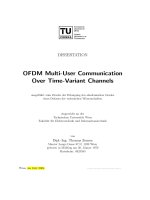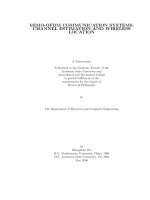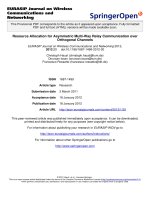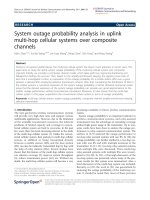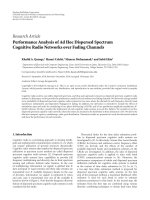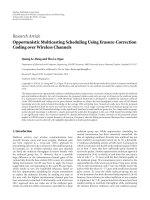OFDM Multi-User Communication Over Time-Variant Channels
Bạn đang xem bản rút gọn của tài liệu. Xem và tải ngay bản đầy đủ của tài liệu tại đây (1.09 MB, 137 trang )
DISSERTATION
OFDM Multi-User Communication
Over Time-Variant Channels
ausgefăhrt zum Zwecke der Erlangung des akademischen Grades
u
eines Doktors der technischen Wissenschaften
eingereicht an der
Technischen Universităt Wien
a
Fakultăt făr Elektrotechnik und Informationstechnik
a u
von
Dipl.-Ing. Thomas Zemen
Maurer Lange Gasse 87/2, 1230 Wien
geboren in Mădling am 20. Jănner 1970
o
a
Matrikelnr. 8925585
Wien, im July 2004
.........................................
Supervisor
Prof. Ernst Bonek
Institut făr Nachrichtentechnik und Hochfrequenztechnik
u
Technische Universităt Wien
a
Examiner
Prof. Markus Rupp
Institut făr Nachrichtentechnik und Hochfrequenztechnik
u
Technische Universităt Wien
a
Kurzfassung
Die Verfăgbarkeit hoher Datenraten făr mobile Teilnehmer ist eine der wichtigu
u
sten Eigenschaften zukănftiger Mobilfunksysteme. Wir untersuchen ein MC-CDMA
u
(multi-carrier code division multiple access) System bei dem eine OFDM (orthogonal
frequency division multiplexing) basierte Mehrtrăgerăbertragung mit der Spreizung
a u
der Datensymbol im Frequenzbereich verbunden wird. Die Spreizsequenz dient zur
Identikation der Benutzer und ermăglicht die Ausnătzung der Mehrwegediversităt
o
u
a
ă
des Mobilfunkkanals. Die Ubertragung ist blockorientiert, wobei sich ein Block aus
OFDM Pilot- und OFDM Datensymbolen zusammensetzt.
Făr Schrittgeschwindigkeit kann der Mobilfunkkanal als konstant făr die Dauer
u
u
eines Datenblocks modelliert werden. Wir verwenden ein iteratives Mehrbenutzerdetektionsverfahren. Hierbei werden Softsymbole aus den Ausgangsdaten des Dekoders
gewonnenen. Mittels dieser Softsymbole kann die Interferenz, die durch andere Benutzer verursacht wird, reduziert werden. Wir entwickeln ein iteratives
Kanalschătzverfahren das die zurăckgefăhrten Softsymbole zur Verbesserung der
a
u
u
Kanalschătzung verwendet. Die Bitfehlerrate des iterativen Empfăngers kommt
a
a
der Einbenutzergrenze nahe. Die Einbenutzergrenze ist die Bitfehlerrate die der
Empfănger făr einen einzelnen Benutzer und bei perfekter Kanalkenntnis erreicht.
a
u
Zur weiteren Verbesserung der Kanalschătzung nătzen wir den geschătzten Mita
u
a
telwert und die geschătzte Varianz der Softsymbole. Diese Informationen kănnen
a
o
aus den Dekoderausgangsdaten abgeleitet werden da die Datensymbole aus einem
Alphabet mit konstantem Betrag stammen. Die iterative Kanalschătzung die diese
a
Informationen zur Minimierung des quadratischen Fehlers (MMSE, minimum mean
square error) nătzt, făhrt zu verbesserter Konvergenz des iterativen Empfăngers.
u
u
a
Bei Fahrzeuggeschwindigkeit ăndert sich der Kanal signikant uber die Dauer
a
ă
eines Datenblocks. Wir benătigen daher eine adăquate Beschreibung seiner zeitlichen
o
a
Verănderung. Wir untersuchen Algorithmen die den zeitvarianten Kanal schătzen
a
a
kănnen, ohne genaue Information uber seine Statistik zweiter Ordnung zu benătigen.
o
ă
o
Es wird nur die Kenntnis der maximalen Dopplerbandreite in einem Mobilfunksystem, die durch die Trăgerfrequenz und die maximale Geschwindigkeit der Benutzer
a
bestimmt ist, angenommen.
Wir untersuchen zuerst zeitvariante frequenzache Kanăle und analysieren die
a
v
Fourier Basisentwicklung făr die zeitvariante Kanalschătzung. Die Analyse zeigt,
u
a
dass die Fensterung durch die begrenzte Blocklănge zu spektraler Verschmierung
a
făhrt und die beschrănkte Dimension der Fourier Basisentwicklung einen Eekt
u
a
ăhnlich dem Gibbs Phănomen verursacht. Beide Mechanismen zusammen sind der
a
a
Grund făr systematische Schătzfehler.
u
a
Slepians Theorie der zeitkonzentrierten und bandlimitierten Sequenzen erănet
o
einen neuen Ansatz făr die zeitvariante Kanalschătzung. Diese Theorie ermăglicht
u
a
o
das Design von doppelt orthogonalen DPS (discrete prolate spheroidal) Sequenzen
die an die Datenblocklănge und die maximale Dopplerbandbreite angepasst sind. Die
a
DPS Sequenzen werden zur Definition der Slepian Basisentwicklung verwendet. Wir
beweisen analytisch, dass der systematische Schătzfehler der Slepian Basisentwicka
lung mindestens eine Zehnerpotenz kleiner ist als der der Fourier Basisentwicklung.
Die Slepian Basisentwicklung verliert ihre Orthogonalităt făr pilotbasierte
a u
Kanalschătzung und ihr systematischer Schătzfehler wăchst mit sinkender Pilotana
a
a
zahl. Wir lăsen dieses Problem durch das Design neuer endlicher Sequenzen die
o
auch auf dem Pilotraster orthogonal sind und weiterhin bandlimitiert und zeitkomprimiert bleiben. Die generalisierte endliche Slepian Basisentwicklung, die auf den
resultierenden generalisierten FDPS (finite discrete prolate spheroidal) Sequenzen
aufbaut, zeigt die beste Leistung făr pilotbasierte Kanalschătzung. Wir beweisen
u
a
dies durch analytische Ergebnisse und prăsentieren numerische Simulationen.
a
Wir verwenden die generalisierte endliche Slepian Basisentwicklung făr die
u
Kanalschătzung eines zeitvarianten frequenzselektiven Kanals in einem MC-CDMA
a
System in der Abwărtstrecke. Simulationsergebnisse zeigen die hervorragende Leisa
tung dieses Kanalschătzverfahrens speziell făr eine geringe Anzahl an Pilotsyma
u
bolen. Der zeitvariante frequenzselektive Kanal bietet Mehrwegediversităt und
a
Dopplerdiversităt. Ein MC-CDMA System kann beide Diversitătsquellen durch Vera
a
schachtelung und Kodierung der Datensymbole ausnătzen. Wir leiten ein analytisu
ches Maò făr die Dopplerdiversităt ab und untersuchen mit Simulationsergebnissen
u
a
wie viel Diversităt ein MC-CDMA System tatsăchlich nătzen kann.
a
a
u
Wir entwickeln in dieser Dissertation eine iterative Empfăngerarchitektur făr die
a
u
Aufwărtsstrecke mit Mehrbenutzerdekodierung făr zeitvariante Mobilfunkkanăle.
a
u
a
Dieser Empfănger năhert sich der Einbenutzergrenze bis auf 2.5 dB unter voller
a
a
Last mit 64 Benutzern, făr ein Signal zu Rauschverhăltnis von 14 dB und mit mou
a
bilen Benutzern die sich mit einer Geschwindigkeit im Bereich von 0 bis 100 km/h
bewegen.
Abstract
Wireless broadband communications for users moving at vehicular speed is a cornerstone of future fourth generation (4G) mobile communication systems. We investigate a multi-carrier (MC) code division multiple access (CDMA) system which is
based on orthogonal frequency division multiplexing (OFDM). A spreading sequence
is used in the frequency domain in order to distinguish individual users and to take
advantage of the multipath diversity of the wireless channel. The transmission is
block oriented. A block consists of OFDM pilot and OFDM data symbols.
At pedestrian velocities the channel can be modelled as block fading. We apply iterative multi-user detection and channel estimation. In iterative receivers soft
symbols are derived from the output of an soft-input soft-output decoder. These
soft symbols are used in order to reduce the interference from other users and to
enhance the channel estimates. We develop an iterative channel estimation scheme
for MC-CDMA. The iterative MC-CDMA receiver achieves a performance close to
the single-user bound in moderately overloaded systems. The single-user bound is
defined as the performance for one user and perfect channel knowledge.
In order to obtain enhanced iterative channel estimates we take advantage of
additional information like the estimated mean and variance of the soft symbols,
which can be obtained from the decoder output since the used symbol alphabet
has constant modulus. Using these information a linear minimum mean square error (MMSE) channel estimator is derived. The iterative receiver achieves enhanced
convergence towards the single-user bound with the linear MMSE channel estimator.
At vehicular velocities, the channel can not be treated as block fading for the duration of a data block. Instead, its temporal variation must be modelled adequately. We
investigate channel estimation algorithms that do not need the knowledge of complete second order statistics. We assume an upper bound for the Doppler bandwidth
only, which is determined by the carrier frequency and the maximum supported
velocity. This approach is motivated by the fact that existent wireless channels do
not adhere to Jakes’ model.
First, we deal with time-variant frequency-flat channels. We analyze the Fourier
basis expansion, i.e. a truncated discrete Fourier transform (DFT), for time-variant
channel estimation. The analysis shows that the windowing due to the block-based
vii
transmission leads to spectral leakage and the truncation of the DFT gives rise to an
effect similar to the Gibbs phenomenon. Both mechanisms together lead to biased
channel estimates.
Slepian’s theory of time-concentrated and bandlimited sequences allows a new
approach for time-variant channel estimation. It enables the design of doubly orthogonal discrete prolate spheroidal (DPS) sequences with just two parameters; the
block length and the maximum Doppler bandwidth. The DPS sequences are used
to define a Slepian basis expansion. We give analytic results showing that the bias
of the Slepian basis expansion is at least one magnitude smaller compared to the
Fourier basis expansion.
The Slepian basis expansion performance degrades for pilot based channel estimation because the orthogonality of the basis functions is lost due to the pilot grid.
We tackle this problem by designing a new set of finite sequences that are orthogonal over the pilot index positions but keep their bandlimited and time-concentrated
properties. The resulting generalized finite Slepian basis expansion achieves best
performance for pilot based time-variant channel estimation which is proven by analytical results and shown in numerical simulations.
We apply the generalized finite Slepian basis expansion for time-variant frequencyselective channel estimation in an MC-CDMA downlink and discuss simulation results. The time-variant frequency-selective channel offers Doppler diversity in addition to multipath diversity. An MC-CDMA system can take advantage of the
Doppler diversity through interleaving and coding over a data block. We derive an
analytic measure for the Doppler diversity of a time-variant channel and support it
by simulation results.
In this thesis, we design an iterative receiver-architecture for an MC-CDMA uplink
with multi-user decoding for time-variant mobile radio channels. It is shown that
this receiver type reaches the single-user bound up to 2.5 dB under full load with
N = 64 users, at an Eb /N0 = 14 dB, and for mobile users moving with velocities in
the range from 0 to 100 km/h.
Acknowledgment
I would like to thank Christoph Mecklenbrăuker for his continuous support and
a
encouragement. His subtle guidance together with Professor Ernst Bonek, Professor Markus Rupp and Ralf Măller helped me to discover new grounds in mobile
u
communications.
A significant part of funding for this research was provided by Siemens AG Austria
from the department for radio communication devices (PSE PRO RCD). I would
like to thank Werner Schladofsky, Martin Birgmeier, Leopold Faltin, Alfred Pohl
and Gănther Hraby for their support.
u
I am grateful to all my colleagues at the Telecommunication Research Center
Vienna (ftw.) especially to Joachim Wehinger, Florian Hammer, Helmut Hofstetter
and Maja Lonˇar. The collaboration with them was a constant source of new ideas,
c
chocolate, coffee and entertaining hours. The professional, inspiring, and open work
environment at ftw., shaped by Markus Kommenda and Horst Rode, provided the
basis for the work on this thesis.
I would like to thank my family and my friends for their continuous sympathy in
my research adventure, and Dada for being the smiling sun in my life.
ix
Contents
1 Introduction
1.1 Outline and Contributions . . . . . . . . . . . . . . . . . . . . . . . .
1.2 Notation . . . . . . . . . . . . . . . . . . . . . . . . . . . . . . . . . .
2 Multi-Carrier Code Division Multiple Access (MC-CDMA)
2.1 Why Multi-Carrier Transmission? . . . . . . . . . . . . .
2.2 Orthogonal Frequency Division Multiplexing (OFDM) . .
2.3 Single-User Signal Model . . . . . . . . . . . . . . . . . .
2.4 Multi-User Signal Model . . . . . . . . . . . . . . . . . .
2.5 Multi-User Detection . . . . . . . . . . . . . . . . . . . .
2.5.1 Spreading Sequences . . . . . . . . . . . . . . . .
2.5.2 Linear Detector Types . . . . . . . . . . . . . . .
2.6 Iterative Multi-User Detection . . . . . . . . . . . . . . .
2.7 Decoder . . . . . . . . . . . . . . . . . . . . . . . . . . .
.
.
.
.
.
.
.
.
.
.
.
.
.
.
.
.
.
.
.
.
.
.
.
.
.
.
.
.
.
.
.
.
.
.
.
.
.
.
.
.
.
.
.
.
.
3 Iterative Channel Estimation for Block-Fading Channels
3.1 Iterative Least-Square Channel Estimation . . . . . . . . . . . . .
3.1.1 Simulation Parameters . . . . . . . . . . . . . . . . . . . .
3.1.2 Simulation Results . . . . . . . . . . . . . . . . . . . . . .
3.1.3 Comparison Between MC-CDMA and DS-CDMA . . . . .
3.1.4 Channel Estimation Error . . . . . . . . . . . . . . . . . .
3.2 Iterative Linear Minimum Mean Square Error Channel Estimation
3.2.1 Simulation Results . . . . . . . . . . . . . . . . . . . . . .
3.2.2 Other Communication Systems . . . . . . . . . . . . . . .
3.3 Block Interleaving . . . . . . . . . . . . . . . . . . . . . . . . . . .
4 Time-Variant Channel Estimation
4.1 How to Deal With Time Variation? . . . . .
4.2 Time-Variant Channel Model . . . . . . . .
4.3 Signal Model for a Frequency-Flat Channel .
4.4 Fourier Basis Expansion and its Deficiencies
.
.
.
.
.
.
.
.
.
.
.
.
.
.
.
.
.
.
.
.
.
.
.
.
.
.
.
.
.
.
.
.
.
.
.
.
.
.
.
.
.
.
.
.
.
.
.
.
.
.
.
.
.
.
.
.
.
.
.
.
.
.
.
.
.
.
.
.
.
.
1
2
5
.
.
.
.
.
.
.
.
.
7
7
10
13
17
19
19
19
21
23
.
.
.
.
.
.
.
.
.
25
25
28
29
31
31
32
35
36
36
.
.
.
.
39
40
41
42
42
xi
.
.
.
.
.
.
.
.
.
.
.
.
.
.
.
.
.
.
43
44
46
50
52
54
56
59
61
62
64
68
68
69
70
70
71
73
5 Time-Variant Frequency-Selective Channel Estimation
5.1 Signal Model . . . . . . . . . . . . . . . . . . . . . . . . . . . . . . .
5.2 Time-Variant Multi-User Detector . . . . . . . . . . . . . . . . . . . .
5.3 Time-Variant Channel Estimator . . . . . . . . . . . . . . . . . . . .
5.4 Simulation Results . . . . . . . . . . . . . . . . . . . . . . . . . . . .
5.5 Doppler Diversity in MC-CDMA . . . . . . . . . . . . . . . . . . . .
5.5.1 Diversity Measure . . . . . . . . . . . . . . . . . . . . . . . . .
5.5.2 Flat-Fading Multiple-Input Multiple-Output (MIMO) Channel
5.5.3 Time-Variant Flat-Fading Single-Input Single-Output Channel
5.5.4 Maximum Diversity for a Given Doppler Bandwidth . . . . . .
5.5.5 Simulation Results . . . . . . . . . . . . . . . . . . . . . . . .
77
78
80
81
82
84
85
85
86
87
88
6 Iterative Multi-User Detection and Time-Variant Channel Estimation
6.1 Uplink Signal Model for Time-Variant Frequency-Selective Channels
6.2 Iterative Time-Variant Multi-User Detection . . . . . . . . . . . . .
6.2.1 Time-Variant Parallel Interference Cancellation . . . . . . .
6.2.2 Time-Variant Unbiased Conditional MMSE Filter . . . . . .
6.3 Iterative Time-Variant Channel Estimation . . . . . . . . . . . . . .
6.3.1 Signal Model for Time-Variant Channel Estimation . . . . .
6.3.2 Linear MMSE Channel Estimation . . . . . . . . . . . . . .
6.3.3 Simulation Results . . . . . . . . . . . . . . . . . . . . . . .
91
92
93
94
94
95
95
97
99
4.5
4.6
4.7
4.8
4.4.1 Numerical Example . . . . . . . . . . . . . . . . . . . . . . .
4.4.2 Definition of the Fourier Basis Expansion . . . . . . . . . . .
4.4.3 Performance Results for Single Path Channel . . . . . . . .
Slepian Basis Expansion . . . . . . . . . . . . . . . . . . . . . . . .
4.5.1 Parameter Estimation From Noisy Observations . . . . . . .
4.5.2 Analytic Performance Results . . . . . . . . . . . . . . . . .
4.5.3 Numerical Performance Results . . . . . . . . . . . . . . . .
Pilot Based Channel Estimation . . . . . . . . . . . . . . . . . . . .
Finite Slepian Basis Expansion . . . . . . . . . . . . . . . . . . . .
4.7.1 Operator Representation . . . . . . . . . . . . . . . . . . . .
4.7.2 Generalized Finite Slepian Basis Expansion . . . . . . . . .
Basis Expansion Error Analysis for Pilot Based Channel Estimation
4.8.1 Basis Expansion Bias . . . . . . . . . . . . . . . . . . . . . .
4.8.2 Basis Expansion Variance . . . . . . . . . . . . . . . . . . .
4.8.3 Simulation Model and System Assumption . . . . . . . . . .
4.8.4 Analytic Results . . . . . . . . . . . . . . . . . . . . . . . .
4.8.5 Numerical Results . . . . . . . . . . . . . . . . . . . . . . .
4.8.6 Further Comparisons and Discussion . . . . . . . . . . . . .
.
.
.
.
.
.
.
.
7 Conclusions
103
A Simulation Model for Time-Variant Channels with Jakes’ Spectrum
107
B List of Abbreviations
109
C List of Symbols
111
Bibliography
115
1 Introduction
Wireless broadband communication for users moving at vehicular speed is the cornerstone of future fourth generation (4G) mobile communication systems. Current
systems like UMTS [1] provide a maximum bit rate of 384 kbit/s for mobile users
while wireless local area network (LAN) systems like IEEE 802.11a [29] provide more
than 10 Mbit/s under ideal conditions in an office environment. Figure 1.1 shows the
mobility bit-rate regions for different communication systems [58].
mobility
pedestrian
nomadic
2nd generation GSM
vehicular
4th generation
3rd generation
UMTS
wireless
LAN
bluetooth
bit rate
0.1
1
10
100 Mbit/s
Figure 1.1: Mobility versus bit rate for existing and future wireless communication
systems [58].
Users moving at vehicular speed communicate over a wireless channel that exhibits time-variant frequency-selective characteristics due to multipath propagation
and Doppler effects. Thus, accurate channel state information at the receiver side,
an appropriate modulation format, an efficient multiple access scheme and low complexity equalization algorithms are necessary to enable high bit rate transmission.
In this thesis we develop solutions for these challenging problems based on orthogonal frequency division multiplexing (OFDM) [81] which uses multiple orthogonal
subcarriers to transmit information. OFDM is used in state of the art wireless high
bit rate applications like digital video broadcast terrestrial (DVB-T) [59, 19], digital
audio broadcast (DAB) [18], digital radio mondial (DRM) [20] and in wireless LANs
according to the IEEE 802.11a standard. For high bit-rate downlink applications
1
1 Introduction
a UMTS extension based on OFDM is under discussion [2]. IEEE 802.20 [30] is
another currently developed high bit-rate communication standard for mobile users
that will be based on OFDM too.
1.1 Outline and Contributions
The thesis is organized in the following chapters and the author’s contributions are
as follows:
Chapter 2: Multi-Carrier Code Division Multiple Access (MC-CDMA)
Starting with multipath propagation in wireless channels the dependence of the
inter-symbol interference on the delay spread and the bit rate is discussed. In order
to avoid the high complexity of time domain equalizers at high bit-rates OFDM [11]
has been introduced. In OFDM the information is transmitted over a set of orthogonal subcarriers which enables low complexity equalization of frequency-selective
channels.
Linear precoding [16], i.e. spreading, has been introduced in order to avoid the
influence of strongly attenuated subcarriers [96] which are caused by the frequencyselective nature of the wireless channel. The spreading operation additionally distinguishes the individual users in a multi-user system [34]. A short introduction of
multi-user detection [75, 50] is given before iterative multi-user detection based on
parallel interference cancellation and minimum mean square error (MMSE) filtering
is introduced [51, 80].
Chapter 3: Iterative Channel Estimation for Block-Fading Channels
Accurate channel estimation is crucial for the performance of a multi-user receiver.
In this chapter we assume that the wireless channel has block-fading frequencyselective characteristic, i.e. the channel stays constant for the duration of a data
block. A data block consists of OFDM pilot and OFDM data symbols.
We design an iterative least-square channel estimation scheme for the MC-CDMA
uplink where deterministic pilot information is combined with soft-symbols in order
to obtain enhanced channel estimates [91]. The soft-symbols are derived from the
output of a soft-input soft-output decoder, implemented using the BCJR algorithm
[6]. An MC-CDMA receiver using this scheme achieves a performance close to the
single-user bound. The single-user bound is defined as the receiver performance for
one user and perfect channel knowledge at the receiver side.
The channel estimation performance degrades if the number of users is bigger than
the degrees of freedom for the spreading sequence (overloaded system). In order to
2
1.1 Outline and Contributions
accommodate to this situation we derive an improved channel estimator based on
the linear MMSE criterion. This estimator exploits statistical information, like the
mean and the variance of the soft-symbols, which can be derived from the decoder
output. Hence, we achieve a monotonically decreasing channel estimation error with
increasing number of iterations in overloaded systems and at low signal to noise
ratios [84].
Chapter 4: Time-Variant Frequency-Flat Channel Estimation
The variation in time of the wireless channel is caused by user mobility and multipath
propagation. In this chapter we limit our considerations to time-variant frequencyflat channels, i.e. the symbol duration is longer than the delay spread of the channel.
In this case the channel is memory-less. We discuss different time-variant channel
estimation methods highlighting their applicability for receivers with block processing. In this thesis we focus on algorithms that do not need complete knowledge of
the second order statistics of the fading process. This is due to the fact that real
wireless channels do not adhere to Jakes’ model [92]. However, we do exploit the
fact that the variation of a frequency-flat channel over the duration of a data block
is upper bounded by the maximum Doppler bandwidth which is determined by the
maximum velocity of the users and the carrier frequency. We analyze the well-known
Fourier basis expansion [9] and show its weaknesses [88].
To overcome the drawbacks of the Fourier basis expansion we exploit results
from the theory of time-concentrated and bandlimited sequences [70, 69] and apply
a Slepian basis expansion for time-variant frequency-flat channel estimation. The
Slepian basis functions are designed according to the block length and the maximum Doppler bandwidth. We establish analytic results for the mean square error
per subcarrier enabling an easy comparison between the Slepian basis expansion and
any other set of basis functions [52]. The bias of the Slepian basis expansion is shown
to be at least one magnitude smaller compared to the Fourier basis expansion.
The Slepian basis expansion is biased when a pilot grid is used for channel estimation. We develop a generalized finite Slepian basis expansion using basis functions
that are time-concentrated, bandlimited, and orthogonal on the pilot grid. This
enables time-variant frequency-flat channel estimation with extremely low complexity [85, 87]. We develop analytic expressions for the bias and variance of pilot-based
basis expansion channel estimators [87] extending the concepts of [52].
We describe a simulation model for time-variant channels with Jakes’ spectrum
based on [93]. This simulation model generates channels with correct Rayleigh fading
statistic for the full velocity range [86] and converges to a block fading channel for
zero velocity. We use Jakes’ model for the purpose of performance evaluation in
order to enable easy comparisons with existing results in the literature only.
3
1 Introduction
Chapter 5: Time-Variant Frequency-Selective Channel Estimation
We develop a channel estimator for an MC-CDMA downlink by generalizing the
results from Chapter 4 for frequency-selective channels [87]. An upper bound for the
Doppler diversity of a time-variant channel [86] is derived and we give simulation
results demonstrating the ability of MC-CDMA to take advantage of Doppler diversity if the channel estimation is based on the finite Slepian basis expansion. The
receiver performs better with increasing speed of the user.
Chapter 6: Iterative Time-Variant Channel Estimation and Data Detection
We present an iterative multi-user detector and time-variant channel estimator for
an MC-CDMA uplink. We apply the Slepian basis expansion for pilot based timevariant frequency-selective channel estimation and combine it with the iterative
scheme developed in Chapter 3. Thus, we combine deterministic pilot information
with soft symbols so that we obtain enhanced time-variant channel estimates. An
iterative linear MMSE estimation algorithm for the basis expansion coefficients in
a multi-user system is derived. The consistent performance of the iterative receiver
for a wide range of velocities is validated by simulations [90, 89].
4
1.2 Notation
1.2 Notation
We use the notation presented in Table 1.1 throughout this thesis:
Symbol
Description
f (t)
f [m]
a
a[i]
A
[A]i,
AP ×Q
AT
AH
diag(a)
IQ
FQ
1Q
0Q
a∗
a
a
|a|
a
A F
vec(A)
j
δi
function of a continuous variable
function of a discrete variable
column vector
i-th element of a
matrix
i, -th element of A
upper left part of A with dimension P × Q
transpose of A
conjugate transpose of A
diagonal matrix with entries a[i]
Q × Q identity matrix
Q × Q unitary Fourier matrix
Q × 1 column vector with all ones
Q × 1 column vector with all zeros
complex conjugate of a
largest integer, lower or equal than a ∈ R
smallest integer, greater or equal than a ∈ R
absolute value of a
2 norm of vector a
Frobenius norm of matrix A
stacks all columns of matrix A in a single vector
√
−1
1 for i = , 0 otherwise
Table 1.1: Notation used throughout this thesis.
5
1 Introduction
6
2 Multi-Carrier Code Division
Multiple Access (MC-CDMA)
Electromagnetic waves are the medium of choice for the transmission of information
between two remote locations if one side or both sides are moving. However, the
flexibility of wireless communication does not come at no cost.
2.1 Why Multi-Carrier Transmission?
Electromagnetic waves, transmitted from an antenna, arrive at the receiving antenna
via different paths. Figure 2.1 gives a simplified schematic representation of such a
wireless multipath wave propagation scenario.
scatterer
η1 δ(t − τ1 )
η0 δ(t − τ0 )
base station
user
η2 δ(t − τ2 )
scatterer
Figure 2.1: Wireless multipath propagation. Every path
time delay τ .
has attenuation η and
Every path experiences a specific attenuation η and time delay τ corresponding
to the runtime of the electromagnetic wave. This is why the channel impulse response
is made up by the sum of L different paths, mathematically described by
L −1
h (t) =
=0
η δ(t − τ ) .
(2.1)
7
2 Multi-Carrier Code Division Multiple Access (MC-CDMA)
Throughout this thesis we use an equivalent sampled baseband description for the
wireless channel. Thus, we combine the effect of the up-converter, the transmit filter
hT (t), the channel h (t), the matched receive filter hR (t) and the down-converter
into the equivalent, complex-valued impulse response
h(t) = hT (t) ∗ h (t) ∗ hR (t)
(2.2)
where ∗ denotes convolution. The sampling operation at rate 1/TC is denoted by
h[ ] = h( TC )
(2.3)
where discrete time ∈ {0, . . . , L − 1} with L denoting the essential support of the
sampled impulse response. We assume Rayleigh fading characteristics [54],
2
2
E |h[ ]| = η [ ]
and an exponential decaying power delay profile η 2 [l] according to COST 259 [15]
η2[ ] =
e
− LD
L−1
e
=0
(2.4)
− LD
where
LD = TD /TC
denotes the root mean square delay spread TD normalized to the sampling rate 1/TC .
In this thesis the term delay spread is used as short form for root mean square delay
spread, throughout. In the special case of an exponential power delay profile (2.4)
the delay spread gives the time after which the power delay profile has decayed to
1/e. For the case of a general impulse response the delay spread is defined as the
second central moment of the power delay profile [56]
L −1
TD =
η2τ
=0
L −1
=0
η2
−
L −1
2
η2τ 2
=0
L −1
2
η
=0
We neglect path loss and assume perfect power control
L−1
η2[ ] = 1 .
=0
8
(2.5)
2.1 Why Multi-Carrier Transmission?
Topology
Delay spread TD
Max. path length difference
40ns
120ns
400ns
15m
35m
120m
office building
corridor
typical urban
Table 2.1: Root mean square delay spread TD in different topologies for a single
reflecting cluster according to COST259 [15].
The essential support of the sampled impulse response L is selected according to
the signal to noise ratio at which the wireless communication system will operate:
L ≥ 1 + TD /TC ln
Eb
N0
.
(2.6)
Hence, components of the channel impulse response that are smaller than the signal
to noise ratio are not taken into account. We also assume perfect time- and frequency
synchronization.
The delay spread TD is mainly influenced by the topology and the material of
the surrounding area. Table 2.1 lists typical values for the delay spread of a single
reflecting cluster [15]. These values are further increased if metallic reflectors are
present. In COST 259 scenarios like bad urban or hilly terrain the possibility of
further reflecting clusters is high. This leads to longer impulse responses consisting
of a superposition of several individual exponential decaying components. For the
sake of simplicity we use the typical urban scenario and model the channel with one
reflecting cluster, only.
Figure 2.2 shows the channel impulse response magnitude |h(t)| of a typical urban
scenario in Oslo. The impulse response was obtained by channel sounder measurements [27]. Additionally, Figure 2.2 shows the sampled impulse response magnitude
|h[n]| sampled at the UMTS sampling rate 1/TC = 3.84 · 106 s−1 .
In a simple communication system the sequence of symbols d[n] is directly transmitted over the multipath channel h[n] where n denotes discrete time at rate 1/TC .
The received signal is given by the convolution of the symbol sequence with the
channel impulse response:
L−1
x[n] =
=0
L−1
h[ ]d[n − ] = h[0]d[n] +
=1
h[ ]d[n − ]
(2.7)
ISI
From (2.6) and Figure 2.2 it becomes clear that the number of samples L that represent the impulse response increase linearly with increasing sample rate 1/TC . Thus,
9
2 Multi-Carrier Code Division Multiple Access (MC-CDMA)
30
20log|h(t)| [dB]
25
20
15
10
5
0
−1
−0.5
0
0.5
1
1.5
2
2.5
3
3.5
t [µs]
Figure 2.2: Impulse response magnitude |h(t)| obtained through channel sounder
measurement in an urban scenario in Oslo [27]. Additionally, we also
depict the sampled impulse response magnitude |h[ ]| sampled at the
UMTS sampling rate 1/TC = 3.84 · 106 s−1 . The time origin was placed
at τ0 , the time delay of the first arriving wavefront.
the inter-symbol interference (ISI) described by the second term in (2.7) increases
too. The application of a time-domain equalizer is the classical approach to remove
the inter-symbol interference. However, a time-domain equalizer gets prohibitively
complex with increasing data rate since the number of operations necessary grows
with O(L2 ).
In the next section we will introduce orthogonal frequency division multiplexing (OFDM). This is a technique that is able to avoids inter-symbol interference
completely [11].
2.2 Orthogonal Frequency Division Multiplexing
(OFDM)
The basic idea of OFDM is to transmit N symbols in parallel over N different
subcarriers [81] while enlarging the symbol duration N times. Figure 2.3 visualizes
the OFDM principle through a rotation of the time-frequency plane. In a singlecarrier system each symbol occupies the full bandwidth. In an multi-carrier system
the symbol duration is enlarged N times and simultaneously the bandwidth consumption of each symbol is reduced by the same factor N . The overall data-rate
10
2.2 Orthogonal Frequency Division Multiplexing (OFDM)
f
f
single carrier
multi carrier
d[0]
d[1]
d[3]
d[7]
d[5]
d[6]
d[3]
d[4]
d[1]
d[2]
d[0]
d[2]
d[4]
d[5]
d[6]
d[7]
t
0 TC
t
NTC
0
Figure 2.3: We illustrate the difference between a single-carrier and a multi-carrier
system through a rotation of the time-frequency plane. The transmitted
data symbols are denoted d[1] . . . d[8]. The multi-carrier system uses N =
8 subcarriers.
magnitude
Df
1
...
...
0
f
fq
f q+1
Figure 2.4: Subcarrier frequency-spectra in an OFDM system. The subcarrier have
bandwidth ∆f . The center frequency of subcarrier q is denoted by fq .
and bandwidth consumption is kept constant trough parallel transmission over N
independent subcarriers.
The subcarrier spectra overlap, as depicted in Figure 2.4. However, if the center
frequency of each subcarrier q is chosen as
fq = q/(N TC )
(2.8)
for q ∈ {0, . . . , N − 1} the subcarriers are orthogonal despite their overlapping
spectra. OFDM is a special case of a multi-carrier scheme with overlapping but
orthogonal subcarriers.
Figure 2.5 shows all operations that are necessary for OFDM. Each subcarrier is
modulated by a symbol (from a binary phase shift keying (BPSK) alphabet in this
example) and the resulting signals are summed up. These operations are equivalent
to an inverse discrete Fourier transform (DFT). The inverse DFT can be efficiently
11
